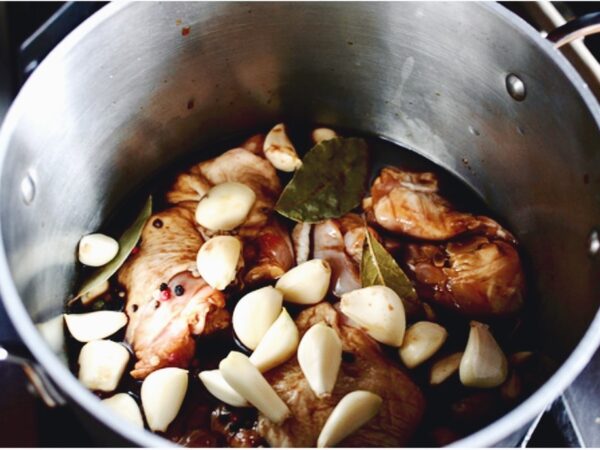by Louise Ayer
Serves 4
I missed my kids. Ramani and I live on Cape Cod and Austin and Anjuli live in Northern California. For months we had been connecting via Zoom. Thank God for Zoom. It has let us stay up to date with them and their community, their very creative and loving community, that is constantly inventing new ways of bringing love and joy and connection to our world, especially to the forgotten and neglected and to restoring the earth. This year alone they had shared over 12,000 meals with the homeless in New York and California.
But the combination of COVID and their intensely busy lives had kept us from being physically together. I missed that connection, our hugs, our sharing of meals and walks, the things that Zoom can’t provide.
Finally we booked our flights and made, what, for us, was the arduous journey to their land. It took us almost 24 hours door to door. We were really beat when we arrived, but I felt a lot of gratitude to Austin for picking us up in San Francisco, taking us out to lunch and finally to Whole Foods for supplies, so I was dying to cook him dinner.
A little crazy considering how tired I was but I felt confident it would not be a problem, because I had the ingredients for Chicken Adobo, as simple to prepare as it gets. Throw the few ingredients in a pot and turn it on. Chicken Adobo, crowd pleaser, low key, accommodating, with some natural charisma and a ton of flavor. The chicken is a little sweet and a little savory, falling off the bone, and accompanied by tender whole cloves of garlic. The vinegar in adobo preserves the chicken over long periods of time, and enables you to basically cook it in the AM and eat it in the PM with no fuss, no refrigeration.
Chicken adobo originated in the Philippines. When the Spanish came to the Philippines in the fifteenth century, they called the dish adobo which is Spanish for marinade. I received it by way of family friends who are Filipino. It is considered the Filipino national dish. It can be made with any kind of meat or fish, but chicken is the most popular.
Note: Filipino adobo is not to be confused with Puerto Rican or Mexican adobo. It also has no resemblance to Goya’s adobo.
Ingredients:
6 organic skin-on, bone-in chicken thighs, washed
1/3 cup soy sauce
1/2 cup balsamic vinegar
1 cup homemade chicken stock (if not available, 1 cup water)
1 teaspoon whole peppercorns (I use a melange of peppercorns, black, red, green and white. They are more flavorful than black alone and a little gentler on the system.)
1 whole head garlic, skins removed
2 bay leaves (or 1 branch of curry leaves)
Peel the garlic. The way I do it is to first break all the cloves off of the head and remove all the flaky outer skin. Then I place the garlic on its side on the cutting board and place the thickest part of a chef’s knife horizontally atop it. Then you hit the knife with the side of a fist enough to break the outer skin but not smash the garlic. (It’s okay if it’s a little bruised.)
Place all the ingredients in a heavy-bottomed pot or Dutch oven. Yes, this means putting in the whole peppercorns and garlic. Bring it to a boil. Once it boils, turn the heat down slightly until it is only a rolling boil (not furiously boiling so much so that the liquid will disappear). Put a lid on and cook for 30 minutes. Every 10 minutes turn the thighs. Turn down to simmer and let it cook for another 15. Take off the heat. Let sit for at least 4 hours away from the stove. The vinegar preserves the chicken, so it can be left to sit covered at room temperature while it marinates. Skim off the fat that has risen to the top. If the sauce is not yet in a solid state, the fat will be the clear slippery liquid floating on the top.
If you want to make the dish more elegant (depending on who the eaters are), you can strain and cook down the sauce. If you choose this option, take out the chicken and garlic and place in a bowl. Strain the sauce through a sieve and discard any solid material. Place the sauce back into the pot and simmer until at desired thickness (about 20 minutes). Let cool. Place the chicken back into the pot until it’s ready to serve.
Heat the chicken back up on medium until warm and serve over brown rice.
Even though Austin has eaten chicken adobo countless times in his life, it had been a while. He kept repeating as he ate his chicken, “This chicken is SO good!!” Chicken adobo feels like home: tender, satisfying, and deeply flavorful.

 Get access to the monthly Rehumanization Magazine featuring contributors from the front lines of this effort—those living on Death Row, residents of the largest women’s prison in the world, renowned ecologists, the food insecure, and veteran correctional officers alike.
Get access to the monthly Rehumanization Magazine featuring contributors from the front lines of this effort—those living on Death Row, residents of the largest women’s prison in the world, renowned ecologists, the food insecure, and veteran correctional officers alike.